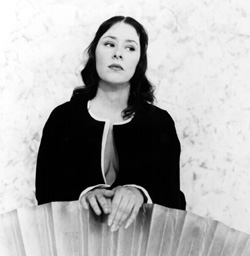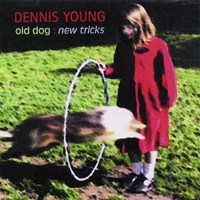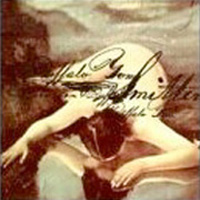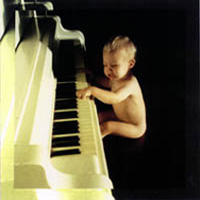 Suzanne Vega
Suzanne Vega
Songs in Red and Gray (A&M)
by Jamie Kiffel
Where has Suzanne Vega been since “Tom’s Diner” doot-doot-dooted its way into our collective unconscious and “Luka” turned an abused child into a top-40 hit? There have been other albums, but, she admits, “I’d sometimes have fifteen minutes to finish the lyrics. I’d have a thesaurus in one hand and a rhyming dictionary in the other.” For a Greenwich Village singer-songwriter, that’s a little like telling fellow Pulitzer prize winners that you’ve been selling self-help books.
But Suzanne is back to make up for that now. She has clearly matured beyond her bare-bones, sometimes clumsy lyrics of over a decade ago and still hits every note like a bell tone. Songs in Red and Gray is moving, singable and laden with metaphors, like Natalie Merchant with more resolve. The question here is whether Vega has tried to lay down more meaning than these New Agey works can support on their crystalline shoulders.
The disc opens with the beautiful, moody “Penitent,” an appropriate title considering that Vega is trying to move away from her shameful history as a rhyming dictionary user. Its twist is the question, “Could I obey?” She wonders if, upon meeting God, she could actually obey God’s commands. Unfortunately, I would never have noticed this twist had I not read the press release very carefully, and I can’t imagine how anyone else would notice it without Cliff’s Notes. It’s hard to say whether having it there adds to the depth of the piece, or actually weakens it as a failed attempt at a deeper meaning.
 “Widow’s Walk” is – according to the sticker on the front – “the hit single.” I haven’t yet heard it on the radio. Regardless, it’s characteristic of the entire first half of the album, which is about failed relationships. The key metaphor is of a woman who calls herself a widow, explaining, “It’s not the man, but it’s the marriage that was drowned.” She describes looking out to sea, explaining that she and her spouse jumped ship before it “hit the rocks.” Again, the tune is strong and the mood entrancing; however, I don’t believe I would have found the message within if I had not taken the time to carefully read the lyrics. The music, while beautiful, does not sound particularly nautical to me, either, which may be why I missed the point.
“Widow’s Walk” is – according to the sticker on the front – “the hit single.” I haven’t yet heard it on the radio. Regardless, it’s characteristic of the entire first half of the album, which is about failed relationships. The key metaphor is of a woman who calls herself a widow, explaining, “It’s not the man, but it’s the marriage that was drowned.” She describes looking out to sea, explaining that she and her spouse jumped ship before it “hit the rocks.” Again, the tune is strong and the mood entrancing; however, I don’t believe I would have found the message within if I had not taken the time to carefully read the lyrics. The music, while beautiful, does not sound particularly nautical to me, either, which may be why I missed the point.
“Maggie May” has a lighter sound but the same thrust: A relationship breaks apart. This song, however, has Vega’s characteristic “Da da das.” Well, if Michael Jackson can say “ow!” on almost every song, why not?
“It Makes Me Wonder” has fascinating lyrics about a man who seems to have a virgin-whore complex: “The Virgin Mary on a chain/ has hit me in the mouth again/ as we explore the carnal score/ of sacred and profane.” Unfortunately, the words are too heavy for the gentle, somewhat ignorable music, and end up sinking right to the bottom of the sound, where they’re easily lost. One reason why they fade away is the fact that Vega occasionally boxes them into measures, disrespectfully breaking clauses in half just to make them fit into musical notation. “It makes me wonder if you are holding me,” she starts – then interrupts herself with music, and finally continues, “to the same blue flame that you are under.” By the time she finishes the sentence, I’ve forgotten what she was saying.
“Soap and Water,” a song about a child caught in the middle of a divorce, makes its sad point through heavy but understandable metaphor: “Daddy’s a dark riddle/ Mama’s a handful of thorns/ You are my little kite caught up in the household storms.” Contrastingly, “Song in Red and Gray” is nearly impossible to understand without an advanced English analysis degree or a lot of experience watching soap operas. It seems to be telling the tale of a woman who, upon meeting her ex-lover’s daughter, feels that the little girl knows that she once slept with her father… though that happened before she was born. Again, breaking up lines in the middle of clauses doesn’t make this piece any easier to comprehend.
With “Last Year’s Troubles,” the disc picks up its pace, even getting calypso-y in spite of its rather sly message: Culture takes what was once a horror and then, after sufficient time has passed, displays it as an object of beauty. This could be a jab at the “Goth” scene, but again, the message is obscured with metaphors and an upbeat tune.
In another case of mismatched music and lyrics, “Priscilla” could be about a loving babysitter, but strange, slightly eerie space noises in the background suggest something menacing. Conversely, “If I Were a Weapon” is about fighting, but its tune is strangely playful. “Harbor Song” sounds more like a bluesy waltz than a seaside plaint.
There are songs here that work, and when they do, they work well. “Machine Ballerina” asks, “Am I a toy on a tray?” listing toys and playful pastimes to a chorus that actually sounds like a wind-up toy marching and sputtering along. The rhymes are smooth and tight, and the optimistic tune works in spite of its sad message. “Solitaire” also makes fantastic onomatopoetic sense, with tick and switch-swish noises – almost like cards flipping – as Vega describes the motions of a game of solitaire. “Jack on the Queen, and the ten on the Jack. It’s a happy repetition… and you are your only competition,” she rhymes, and the musical movement is tight and perfect.
The disc ends with “St. Clare,” a song by Jack Hardy. It’s the only place where Vega lets her voice slide up to notes. To me, that ruins it; anything musically lacking on the rest of the album is forgivable when pronounced by Vega’s beautifully ringing tones.
Ultimately, this is, though technically flawed, a beautifully listenable album. The music and lyrics are both independently strong. But, like the estranged men and women they describe, they seem unable to embrace one another.
(www.suzannevega.com)



